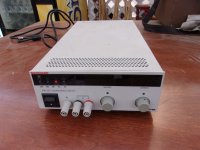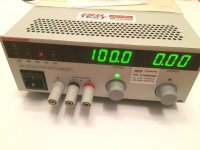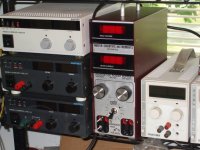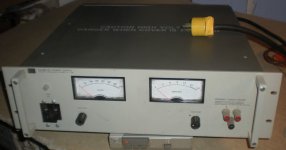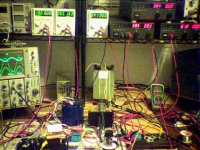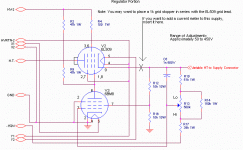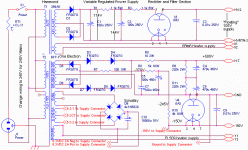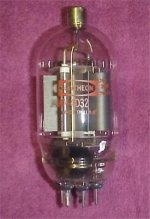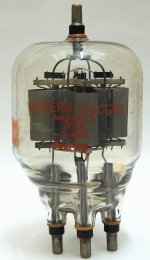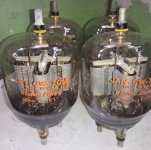The circuit requires about 150v more input than output to deliver full current.
This fully depends on the characteristics of the pass tube(s).
6S33S requires 120 V over the tube when anode current is 500 mA.
I think the minimum is 3 pcs. of 6S33S as pass tubes to meet your requirements
Yes, that's why I said "this circuit". This circuit is based around a pentode, and likely couldn't drive a triode properly. Also, using parallel EL509s, I'll save about as much energy on heaters as the 6S33S would save on dissipation. I'll likely play around with the 6S33S on a later occasion.This fully depends on the characteristics of the pass tube(s)
Are you stuck on using a tube here? This sounds like a situation where a SS device and a heatsink may really be a better path.
Quite stuck on using a tube here I'm afraid, I want to build one amp without silicon in anything but the transformer steel. I know it's impractical, but maybe I can get this bug out of my system. Heck, thing even has dc filaments in the audio tubes, and that uses two tungar bulbs for rectification.
I'll use logic on the next build.
I'll use logic on the next build.
Could mount some big dummy tubes on the top.
Xantrex/Sorensen/Ametek XHR 600 -used- to be cheap on Ebay 15 years ago (14 lbs).
Maybe a DCS 600 or EMI 600, DCS 600, XFR 600, XG 600 can be found reasonably ($) now.
TCR 600 or DCR 600 should be cheap, but -OLD- and heavy and noisy.
or HP6448 expensive, -OLD- and heavy and noisy.
Attachments
Last edited:
Could mount some big dummy tubes on the top.
If it's in there, it has to do something. Also that would really be a waste of filament power, and tube life for it to do nothing. As far as not lighting them up, what even is the point?
A quick search reveals all of those are quite expensive still.
I'll just parallel some EL509s, and put a 10 Ohm resistor on each plate to share current . My only concern is whether a single 6bm8 can drive all 4 pass tubes. In theory the grid shouldn't pull any current, but being at a positive voltage it may. That 6bm8 plate/ EL509 grid is only at 100v max or so, and that's through 94k of resistance. If they are pulling a bit of current on the grids, would reducing the resistance from the 105v rail to the 6bm8 plate/ EL509 grid help give the error amplifier more drive ability?
Yeah, I don't understand what has happened on Ebay lately.
Used to get an XHR for $50 "for repair" or $300 "working". Now they want as much for a used one as a new one!
Ebay's fees must to be reaching the "shake down, assault" level.
$1000 for an HP 6448 dumpster rescue. I paid $50 for two of them 12 years ago, then gave them away when I got some XHRs.
Used to get an XHR for $50 "for repair" or $300 "working". Now they want as much for a used one as a new one!
Ebay's fees must to be reaching the "shake down, assault" level.
$1000 for an HP 6448 dumpster rescue. I paid $50 for two of them 12 years ago, then gave them away when I got some XHRs.
Attachments
Last edited:
I'll just parallel some EL509s, and put a 10 Ohm resistor on each plate to share current . My only concern is whether a single 6bm8 can drive all 4 pass tubes. In theory the grid shouldn't pull any current, but being at a positive voltage it may. That 6bm8 plate/ EL509 grid is only at 100v max or so, and that's through 94k of resistance. If they are pulling a bit of current on the grids, would reducing the resistance from the 105v rail to the 6bm8 plate/ EL509 grid help give the error amplifier more drive ability?
If this will be built with EL509s, some 6 pcs. is the minimum. Max. plate dissipation of EL509 is 35 W. The total dissipated power is 200 W. Even 6 pcs. of EL509 is marginal and these should be well matched.
Put 10 ohms resistors at the cathode, not at the plate. The current equalizing effect of these resistors is greater at the cathode.
Any pentode can "drive" these pass tubes, since there will not (and can not) be any grid current. A triode connected EL509 draw 500 mA current at 160 V plate voltage while Ug1 = -17 V.
In any case, when pass tube(s) go to grid current (Ug1 = 0 V) the operation of the regulator collapses.
If this will be built with EL509s, some 6 pcs. is the minimum. Max. plate dissipation of EL509 is 35 W. The total dissipated power is 200 W. Even 6 pcs. of EL509 is marginal and these should be well matched.
Put 10 ohms resistors at the cathode, not at the plate. The current equalizing effect of these resistors is greater at the cathode.
Any pentode can "drive" these pass tubes, since there will not (and can not) be any grid current. A triode connected EL509 draw 500 mA current at 160 V plate voltage while Ug1 = -17 V.
In any case, when pass tube(s) go to grid current (Ug1 = 0 V) the operation of the regulator collapses.
I'll either nudge down the voltage drop, or use 6 tubes.
Regulators tend to shoot for the lowest possible output impedance, so wouldn't putting resistors on the cathode hurt that? In this circuit with a single EL509, the output impedance is about .7ohm.
The grid of the EL509 is connected in series with 94kohm to a 105v supply, the return of that supply is connected to the cathode (output). Wouldn't ug1 be up to +105v?
If the cathode was grounded, any pass tube would explode or melt, because it is biased to near infinite conduction, no? Instead the load is in series with it to limit the current to whatever the load asks for.
So being that the grid is in fact positive, could it not draw a small amount from the cathode to it?
$1000 for an HP 6448 dumpster rescue.
I got mine for free...OK the cost of gas for a 200 mile drive. It's ultra slow response time coupled with it's 1000uF of output cap guarantees destruction of parts when things go wrong. The recent fireball that burned a hole through a PC board and turned an OPT into a magnet was due to a dumb blonde stuffing over 1KV (plate voltage on a 160 watt amp) into a resistor rated for 300 volts.
Other than that, it's a good power supply for the price I paid for it.
Really, If I was making a regulator to turn 800 volts into 600 volts at 1 amp I would use either a 2SK3581 (600V @43A) or a 2SK3549 (900 V @ 10 A), as I have some of both.....
If you must use a tube several TV sweep tubes are really the only affordable answer.
Here is some testing I performed on a big sweep tube. The on time was short due to some extreme plate dissipation (500+ watts!). It proves that you can hit an amp or more with 150 volts on the plate. Several tubes would need to be connected in parallel to satisfy plate and G2 dissipation ratings.
Attachments
Regulators tend to shoot for the lowest possible output impedance, so wouldn't putting resistors on the cathode hurt that?
No, the output impedance of the regulator is determined by the loop gain and NFB used.
The effect of cathode resistors is just to equalize the tube differences and do not effect to output impedance.
In this circuit with a single EL509, the output impedance is about .7ohm.
If you already have an idea about the circuit/schematic, please show it.
Definitely determined to use tubes this one time.
A pair of tested used Svetlana EL509s costs $18 on ebay with free shipping. Is that not cheap?
Though with the number of tubes, I'm starting to reconsider the 6S33S tubes mentioned earlier. Does the pass tube being a pentode aid in the ripple rejection at all? Also, I read that triode pass tubes require more drive, so would I need to increase the 105v supply to, say, 150v? It would still be 3 more Amps for the 6S33S, but it takes it from 6 to 3 tubes. It would, however, cost 3x as much for the 3x 6S33S vs 6x EL509.
What tube were you using for that test?
A pair of tested used Svetlana EL509s costs $18 on ebay with free shipping. Is that not cheap?
Though with the number of tubes, I'm starting to reconsider the 6S33S tubes mentioned earlier. Does the pass tube being a pentode aid in the ripple rejection at all? Also, I read that triode pass tubes require more drive, so would I need to increase the 105v supply to, say, 150v? It would still be 3 more Amps for the 6S33S, but it takes it from 6 to 3 tubes. It would, however, cost 3x as much for the 3x 6S33S vs 6x EL509.
What tube were you using for that test?
If you already have an idea about the circuit/schematic, please show it.
It's from the link posted earlier in the thread, note: not my schematic.
Attachments
What tube were you using for that test?
That was a 6LW6. They have become rather scarce lately, but most of the big (35+ watts plate dissipation) have peak current capabilities in the 1.0 to 1.4 amp range. Some of the older flavors can still be found relatively cheap.
The 6DQ5 is rated for 315 mA continuous, 1100 mA peak
The 6HJ5 is rated for 280 mA continuous, 1000 mA peak
The 6JE6C / 6LQ6 350 mA continuous, 1200 peak
The 6KD6 400 mA continuous, 1400 peak
The 6KN6 400 mA continuous, 1400 peak
the 6LR6 375 mA 1300 peak
the 6LW6 400 mA continuous, 1400 peak
Many of these are also made with odd heater voltages. These can usually be considerably cheaper than their 6.3 volt brothers, and can often be found in a voltage that can be powered by an Antek toroid or an SMPS. Keep in mind that the cathode operated at the regulator's output voltage. This requires a separate heater supply capable of operating at the same voltage or the HK breakdown voltage will be exceeded and the tube will have a short unhappy life.
There is the 38HE7 tube which is on the $1 list at ESRC. It is rated 230 mA DC, 800 mA peak, and 10 Watts.
Around 80% of the 38HE7 tubes I've seen have a separate pin for powering just the pentode, with a 21V heater then. Without the damper diode powered up, one should be able to get 14 Watts diss. for the pentode alone.
So ten tubes for $10, for 2.3 Amps and 100 Watts conservatively. The sockets are going to be the big cost.
You might want to put the regulator in the neg. supply leg, so the series pass tube heater power doesn't need to be elevated so much. Use a HV P channel (or PNP) differential pair in the regulator to control the 38HE7 grids.
An R divider from +V down to output ground (tube plates) controls one gate, and a V reference provided on the other gate. The correctly phased Drain controls the 38HE7 grids. DC coupled.
Around 80% of the 38HE7 tubes I've seen have a separate pin for powering just the pentode, with a 21V heater then. Without the damper diode powered up, one should be able to get 14 Watts diss. for the pentode alone.
So ten tubes for $10, for 2.3 Amps and 100 Watts conservatively. The sockets are going to be the big cost.
You might want to put the regulator in the neg. supply leg, so the series pass tube heater power doesn't need to be elevated so much. Use a HV P channel (or PNP) differential pair in the regulator to control the 38HE7 grids.
An R divider from +V down to output ground (tube plates) controls one gate, and a V reference provided on the other gate. The correctly phased Drain controls the 38HE7 grids. DC coupled.
Last edited:
I'll have to look around at flea markets and antique shops to see if I can find some big sweep tubes for cheap. If not oh well.
The problem I see with the 38HE7 is that it has 10w dissipation rating, and I need 200. That's 20 tubes. Even at a dollar a piece, the cost of sockets and the sheer number of tubes makes me want to avoid that route. I'd rather pay $54 for the EL509s and only have 6.
Luckily 350v heater elevation allows for every EL509, even from the other two regulators, to have the heaters on the same circuit without exceeding the heater to cathode voltage limitation on any of the tubes. One of the regulators is for 350v, so that works perfectly.
The problem I see with the 38HE7 is that it has 10w dissipation rating, and I need 200. That's 20 tubes. Even at a dollar a piece, the cost of sockets and the sheer number of tubes makes me want to avoid that route. I'd rather pay $54 for the EL509s and only have 6.
Luckily 350v heater elevation allows for every EL509, even from the other two regulators, to have the heaters on the same circuit without exceeding the heater to cathode voltage limitation on any of the tubes. One of the regulators is for 350v, so that works perfectly.
Some bigger (but inexpensive) tubes listed at ESRC and at Vacuumtubes.net:
Will need around 8 or 9 or 10 tubes for 200 Watt
All have plate caps.
6EX6 $5 22 Watt 220 mA DC Octal
21EX6 $3
6DQ5 $10 24 Watt 315 mA DC Octal
26DQ5 $3/$5 (may be supply limited at $3)
6CB5A $5 26 Watt 240 mA DC Octal
21LG6A $4 28 Watt 315 mA DC 12 pin Compactron
Ebay: 4D32 $25 50 Watt 300 mA DC, weird socket & plate cap
Will need around 8 or 9 or 10 tubes for 200 Watt
All have plate caps.
6EX6 $5 22 Watt 220 mA DC Octal
21EX6 $3
6DQ5 $10 24 Watt 315 mA DC Octal
26DQ5 $3/$5 (may be supply limited at $3)
6CB5A $5 26 Watt 240 mA DC Octal
21LG6A $4 28 Watt 315 mA DC 12 pin Compactron
Ebay: 4D32 $25 50 Watt 300 mA DC, weird socket & plate cap
Attachments
Last edited:
701A 100 Watt, high current, DIY base, $75 (Vacuumtubes.net)
Now THAT looks cool enough to spend $150 on. Though at this point I may stick with the EL509s, since they're $9 a piece. It'd be cheaper, it's what that circuit is set up for, has a normal filament voltage, and is indirectly heated.
I'd imagine those big ones are directly heated, so wouldn't I have to run dc on the filament to avoid hum on the output?
- Status
- This old topic is closed. If you want to reopen this topic, contact a moderator using the "Report Post" button.
- Home
- Amplifiers
- Tubes / Valves
- Big Tube based voltage regulator
